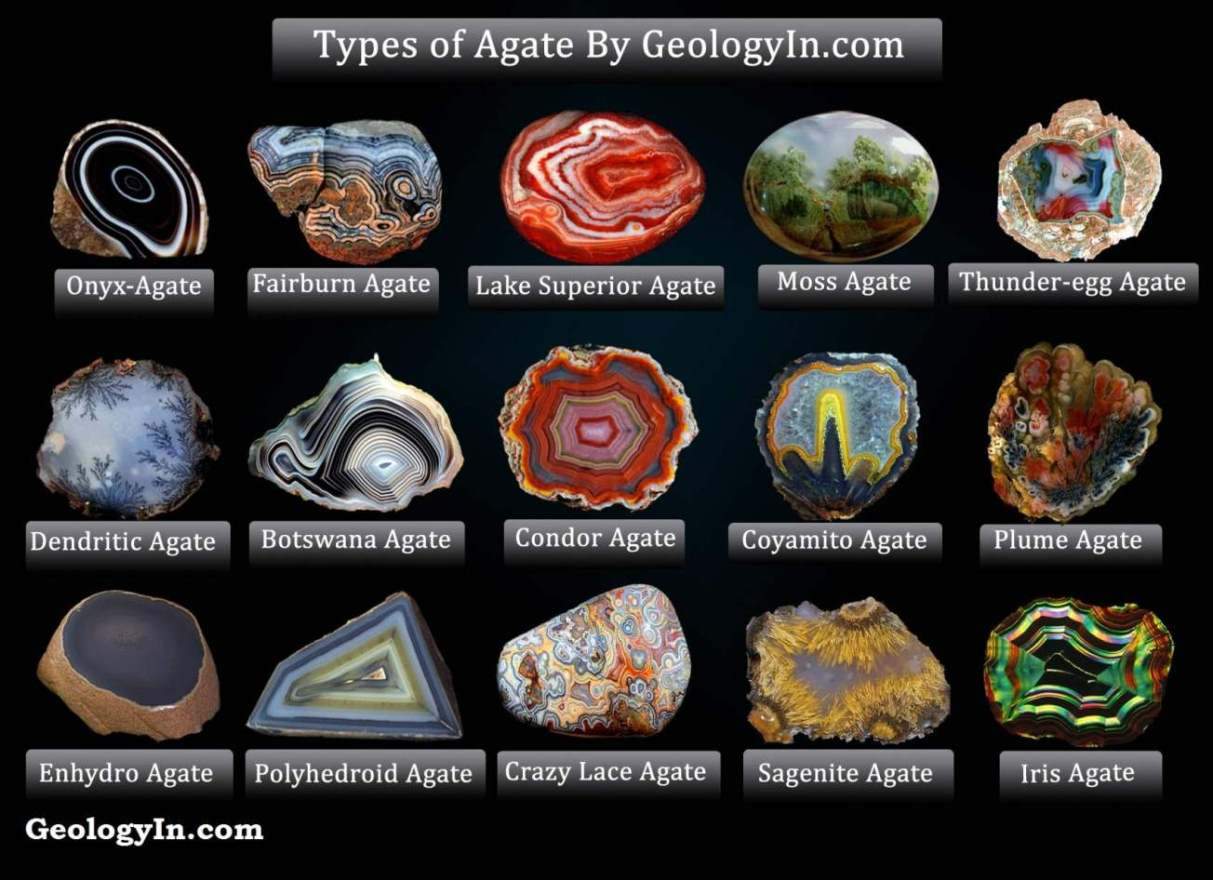Basalt: Composition, Properties, Types, Uses
Basalt is a fine-grained, extrusive igneous rock, formed from the cooling of molten lava (magma) erupting from volcanoes. Basalt constitutes the Earth's most abundant igneous rock type, estimated to comprise approximately 70% of the planet's crust. It's typically fine-grained and dark in color due to its high content of iron and magnesium.
Basalt is dark in color, typically black or gray, due to its high iron and magnesium content. Basalt is fine-grained and typically has a dense, compact structure.
Basalt is typically composed of plagioclase feldspar, pyroxene, and olivine. It can be found in a variety of textures, including aphanitic (fine-grained), porphyritic (with large crystals embedded in a fine-grained matrix), and vesicular (with holes or bubbles).
Basalt is a fine-grained, dark-colored igneous rock that makes up over 90% of the Earth's volcanic rock and covers vast areas of the ocean floor. It's formed from the rapid cooling of molten lava, often at mid-ocean ridges or hotspots.
The term "basalt" is derived from the Latin word "basaltes," which likely originated from the Greek word "basanos" meaning "touchstone," a dark-colored stone used to test the purity of gold.
Basalt is classified as a "mafic" rock due to its low silica content.
Basalt Key Features:
- Category: Igneous, Volcanic, Extrusive
- Chemical Composition: Mafic (low in silica, high in iron and magnesium)
- Color: Grey to black, with potential green, red, or brown hues depending on the presence of specific minerals.
- Texture: Fine-grained (aphanitic), sometimes porphyritic (containing larger crystals) or vesicular (containing cavities).
- Hardness: Moderate (5-6 on Mohs scale), suitable for construction purposes.
- Mineral Composition: Dominantly plagioclase feldspar, pyroxene, and olivine, with accessory minerals like magnetite, ilmenite, and trace elements.
 |
| Basalt volcanic rock |
Basalt Mineral and Chemical Composition
Basalt, a volcanic rock, boasts a fascinating composition that reflects its fiery origin. Classified as a mafic igneous rock, it's characterized by its dark color and abundance of minerals rich in magnesium (Mg) and iron (Fe).
Chemical composition
Basalt's overall composition is classified as mafic, meaning it's rich in magnesium (Mg) and iron (Fe) and low in silica (SiO₂). Typical ranges for key elements include:
Silica (SiO₂): 45-52% - This major component defines basalt as a mafic rock. Higher silica content leads to other rock classifications like andesite.
Alkalis (Na₂O + K₂O): 2-5% - Relatively low compared to other rock types, reflecting the abundance of magnesium and calcium in basalt.
Iron oxides (FeO and Fe₂O₃): 5-14% - These oxides contribute to the dark color and give basalt its high density.
Calcium oxide (CaO): ~10% - A key component of plagioclase feldspar, a dominant mineral in basalt.
Magnesium oxide (MgO): 5-12% - Another major component, signifying the abundance of magnesium-rich minerals like olivine and pyroxene.
Aluminum oxide (Al₂O₃): 14% or more - This oxide forms the backbone of feldspar and pyroxene minerals.
Other elements: Trace amounts of elements like titanium, phosphorus, and manganese are also present.
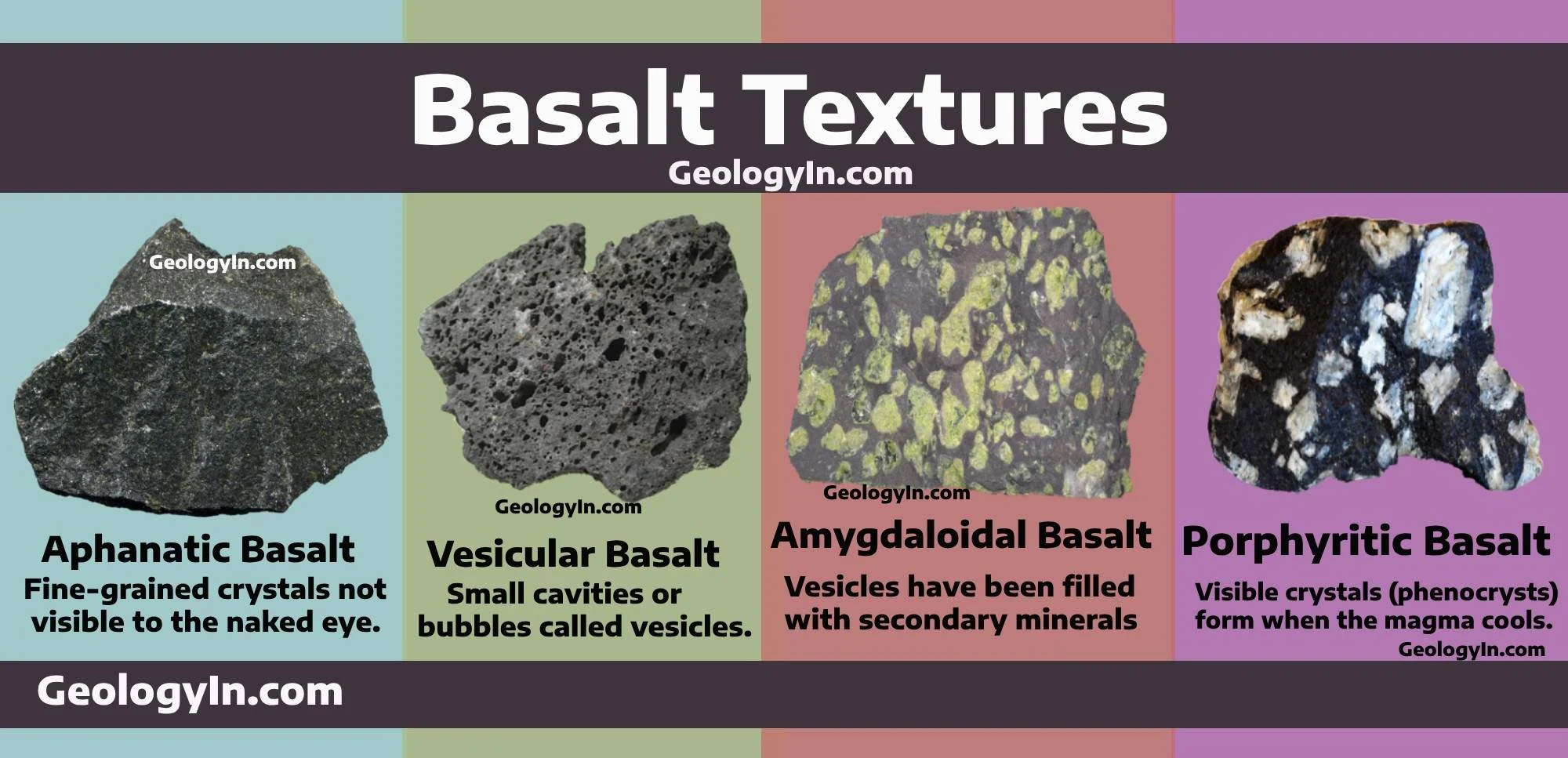 |
| Basalt Texture, Aphanitic, Porphyritic, Vesicular, Amygdaloidal |
Basalt Mineral Composition
Basalt, the Earth's most common igneous rock, exhibits a distinctive
mineralogical composition that defines its physical and chemical
characteristics. This composition is dominated by a specific assemblage
of rock-forming minerals, each playing a crucial role in the rock's
genesis and properties.
Primary Minerals
Plagioclase Feldspar (50-65%): This calcium-rich feldspar forms the backbone of basalt, with labradorite being the most common variety. Its presence indicates crystallization at high temperatures.
Pyroxene (20-35%): These silicate minerals, commonly augite or pigeonite, come in various forms depending on the specific elements present. They contribute to basalt's dark color and toughness.
Olivine (0-15%): This magnesium-iron silicate is often present in high-temperature basalts, but its abundance can vary depending on the cooling rate and composition of the magma. Its presence indicates rapid cooling.
Magnetite (5-10%): This iron oxide mineral contributes to basalt's magnetic properties and can be extracted for industrial use.
Accessory Minerals:
Apatite, Amphibole, Biotite: These minerals can be present in varying amounts depending on the specific type of basalt and its formation conditions.
Factors Affecting Composition
Magma Origin: The composition of the mantle source region of the magma influences the specific minerals that crystallize, leading to subtle variations in basalt types.
Cooling Rate: Faster cooling can trap minerals like olivine in the rock, while slower cooling might allow them to react and transform into other minerals.
Differentiation: During magma ascent and crystallization, minerals can separate and concentrate, leading to specialized basalt types with higher abundances of specific minerals.
 |
| Mineral composition in Basalt thin section: Plagioclase, Pyroxene. Photo: J.M-Derochette |
Basalt Classification
Basalt is a diverse rock type, and there are several ways to categorize it based on different characteristics. Here are some of the most common classifications:
Classification By composition
Tholeiitic basalts: These are the most common type, characterized by a silica content between 45-52% and a relative abundance of calcium-poor pyroxene. They form the majority of oceanic crust and are also found in continental settings.
Alkali basalts: These have a higher silica content (45-55%) and are richer in sodium and potassium oxides than tholeiites. They are commonly found in continental rift zones and oceanic islands.
Transitional basalts: As the name suggests, these fall between tholeiites and alkali basalts in terms of their composition. They are relatively rare but can be found in various tectonic settings.
Classification By Mineralogy
This classification focuses on the dominant minerals present. Some examples include:
Olivine basalt: Rich in olivine, a green or brown magnesium-iron silicate.
Clinopyroxene basalt: Dominated by augite or pigeonite, calcium-magnesium-iron silicates.
Plagioclase basalt: High in plagioclase feldspar, a sodium-calcium aluminosilicate.
Classification By Texture
 |
| Amygdaloidal basalt |
This describes the size of individual mineral crystals in the rock. Basalts can be:
Aphanitic Basalt: These are fine-grained basalts with a smooth, almost glassy appearance. They are the most common type of basalt, formed by rapid cooling of lava.
Porphyritic Basalt: These basalts have larger crystals (phenocrysts) embedded in a finer-grained matrix. The phenocrysts can be of various minerals, such as olivine, pyroxene, or plagioclase.
Vesicular Basalt: These basalts contain bubbles or cavities (vesicles) formed by expanding gases during eruption. They are often found in lava flows and cinder cones.
Amygdaloidal Basalt: Amygdaloidal texture refers to the presence of gas
bubbles or vesicles that were trapped in the lava during its eruption
and later filled with minerals after the rock solidified. These
fillings, called amygdules, are typically rounded or almond-shaped
(hence the name, derived from the Latin word for "almond").
Columnar basalt: This type features vertical columns formed by the contraction of cooling lava. It's often seen in volcanic landscapes like the Giant's Causeway.
Pillow basalt: This type forms rounded, pillow-like structures when lava erupts underwater. It's common in the ocean floor.
Pahoehoe and Aa lava: These refer to different surface textures of lava flows. Pahoehoe is smooth and ropy, while Aa is rough and blocky.
Classification by Tectonic Setting
Based on the plate tectonic context, basalts can be categorized as
Mid-Ocean Ridge Basalt (MORB): These basalts erupt at ocean ridges, where tectonic plates diverge. They are typically tholeiitic and have a relatively uniform composition.
Ocean Island Basalt (OIB): These basalts erupt from hot spots within the mantle, creating islands like Hawaii. They can be tholeiitic or alkali, and are often more diverse in composition than MORBs.
Subduction Zone Basalt: These basalts form at subduction zones where oceanic plates sink beneath continental plates. They are often enriched in water and other volatile elements due to subducted sediments.
Continental Flood Basalt: These massive lava flows cover large areas of continents, often triggered by mantle plumes. They can be tholeiitic or alkali, depending on the underlying geology.
Classification By formation Location
Subaerial: These basalts erupt onto the land surface, forming lava flows, cinder cones, and other volcanic features.
Submarine: These basalts erupt underwater, forming pillow lavas and contributing to the growth of oceanic crust.
Additional Classifications
High-Ti vs. Low-Ti Basalt: Based on titanium content, affecting color and eruption style.
Alteration: Basalt can be altered by weathering or hydrothermal processes, creating subcategories like greenstone.
Total Alkali-Silica (TAS) diagram: Plots silica and total alkali content, further subdiving basalt types.
Normative mineralogy: Uses idealized "normative" minerals to classify based on chemical composition.
Each classification system sheds light on different aspects of basalt, and often, multiple criteria are combined for a more complete understanding. For example, a specific basalt could be described as a "vesicular olivine tholeiite erupted subaerially in an island arc setting."
Basalt Properties
Color: While typically described as black, basalt can exhibit a range of hues due to variations in mineral composition and oxidation. Shades of grey, green, and even reddish-brown are possible.
Texture: Basalt exhibits a wide range of textures, from fine-grained and aphanitic (almost glass-like) to coarse-grained and porphyritic (containing larger crystals within a finer matrix). These variations arise from differences in cooling rates and magma composition.
Hardness: Basalt is a relatively hard rock, typically falling between 5-6 on the Mohs scale of mineral hardness. This makes it resistant to weathering and erosion, contributing to its widespread presence on Earth's surface.
Mineral Composition: Primarily composed of silicate minerals, basalt typically contains plagioclase feldspar, pyroxene (augite and diopside), and sometimes olivine. Accessory minerals like magnetite, ilmenite, and apatite can also be present.
Composition: Basalt's chemical composition is dominated by silicon dioxide (SiO₂) (45-52%) and aluminum oxide (Al₂O₃) (14-18%), along with significant amounts of iron oxides (FeO, Fe₂O₃) (5-14%), calcium oxide (CaO) (around 10%), and magnesium oxide (MgO) (5-12%). The relative abundance of these elements determines the specific type of basalt.
Density: Basalt is a relatively dense rock, typically with a density between 2.7 and 3.0 g/cm³. This density contributes to its role in forming the ocean floor and shaping volcanic features.
Weathering Resistance: While resistant to physical weathering like erosion, basalt can be susceptible to chemical weathering due to the presence of minerals like feldspar and olivine. This can lead to the breakdown of the rock and the formation of clay minerals.
Magnetism: Basalt often contains iron oxides, which can give it magnetic properties. This can be useful for understanding the Earth's magnetic field and the history of plate tectonics.
Where is Basalt Found
Oceanic Basalt
Mid-ocean Ridges: The majority of basalt resides in the ocean floor, forming the crust of oceanic tectonic plates. As plates diverge at Mid-Ocean Ridges, molten mantle rises, cools, and solidifies into basaltic seafloor. This process forms vast underwater mountain ranges, like the Mid-Atlantic Ridge, composed primarily of basalt. This is because the upwelling mantle beneath mid-ocean ridges melts partially, producing basaltic lava that solidifies as it spreads outward. It's estimated that over 90% of all volcanic rock on Earth is basaltic, with the oceanic crust being predominantly composed of this rock type.
Oceanic Hotspots: Plumes of hot mantle rising from the Earth's core, known as hotspots, can erupt basaltic magma over stationary tectonic plates. This creates isolated chains of volcanic islands like the Hawaiian Islands or Iceland.
Continental Basalt
Flood Basalts: These massive outpourings of basalt magma cover large areas, often exceeding thousands of square kilometers. Examples include the Deccan Traps in India, the Siberian Traps in Russia, and the Columbia River Plateau in the US. These eruptions are thought to be triggered by mantle plumes or rifting events within continents.
Volcanic Arcs: Where oceanic and continental plates converge, subduction zones form. As the oceanic plate descends, its water content melts the overlying mantle, generating magma that erupts as basalt volcanoes, forming island arcs and continental mountain chains like the Andes.
Precambrian basalts: formed billions of years ago, are often found in fold and thrust belts, remnants of ancient mountain ranges. These rocks have undergone significant metamorphism, transforming the original basalt into green-colored rocks known as greenstones.
Beyond Earth
Basalt found on other planets. Basalt is common on the Moon, Mars, and Venus, indicating widespread volcanic activity in their history.
Moon: The dark "maria" regions on the Moon are vast plains of basaltic lava flows, solidified remnants of ancient volcanic activity.
Mars: Evidence suggests widespread basaltic plains and volcanic features on Mars, indicating past volcanic activity.
Other Solar System Bodies: Basalt has been detected on Venus, Mercury, and even the asteroid Vesta, suggesting its widespread occurrence throughout our solar system.
Basalt Types and Varieties
Tholeiitic Basalt
 |
| Tholeiitic Basalt, from the Pliocene of Oregon, USA. |
The most common type of basalt, tholeiite is characterized by its silica saturation (SiO₂ content around 45-52%) and relatively high iron and magnesium content. Plagioclase feldspar and pyroxene are the primary minerals, with minor olivine and oxides.
Origin: Mid-ocean ridge (MOR) basalts, the most common type, originate from partial melting of depleted mantle peridotite at spreading centers. This process enriches the melt in silica (SiO₂) and aluminum oxide (Al₂O₃) while depleting it in incompatible elements like potassium (K) and sodium (Na).
Composition: Tholeiitic basalt typically contains plagioclase feldspar (labradorite or bytownite) as the primary mineral, along with clinopyroxene (augite or pigeonite) and olivine in varying proportions. It is typically fine-grained and aphanitic (without visible crystals).
Texture: Tholeiitic basalt can exhibit a variety of textures, including massive, columnar, and pillow-shaped. The rapid cooling of submarine eruptions often leads to fine-grained textures, while subaerial flows may develop columnar jointing due to contraction during cooling.
Flow behavior: Fluid when molten, forming smooth, ropy "pahoehoe" lava flows.
Characteristics: Tholeiites are characterized by low K potassium and Na sodium content (typically <2% each), with higher iron oxide (FeO) and magnesium oxide (MgO) concentrations (ranging from 5% to 14% each). They exhibit fine-grained textures and often display columnar jointing due to contraction during cooling.
Alkali Basalt
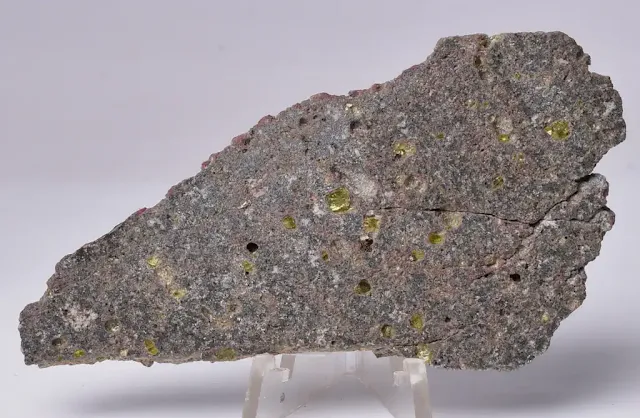 |
| Alkali Basalt, |
Alkali Basalt: Compared to tholeiite, alkali basalt has a higher silica content (typically 48-52%) and is enriched in alkali elements like sodium and potassium. This difference in composition reflects the involvement of enriched mantle sources or interaction with crustal material during magma formation.
Origin: Alkali basalt is common in continental settings, erupting in rift zones, volcanic arcs, and intraplate hotspots. It forms from the partial melting of enriched mantle sources, resulting in a magma richer in silica, sodium, and potassium compared to tholeiite.
Composition: Alkali basalt typically contains plagioclase feldspar (labradorite or andesine) as the primary mineral, along with clinopyroxene (augite or titanaugite) and olivine (less common than in tholeiite). It can also contain minor amounts of feldspathoids (nepheline, leucite) in silica-undersaturated varieties.
Texture: Alkali basalt can exhibit a wider range of textures compared to tholeiite, including aphanitic, porphyritic (with larger crystals), and vesicular (with gas bubbles). The presence of feldspathoids can also lead to glassy or trachytic textures.
Special Characteristics: Alkali
basalt is enriched in incompatible elements like potassium, sodium, and
titanium compared to tholeiite. It is more diverse in its composition
and texture, reflecting the varied sources and eruption environments.
High-Titanium Basalt (HTB)
 |
| High-Ti basalt from the Moon |
High-Ti basalt is a type of basalt enriched in titanium.
Origin: HTB is a specific type of basalt found in large igneous provinces (LIPs) and flood basalt events. It is thought to form from the melting of enriched mantle plumes, resulting in a magma rich in titanium and other incompatible elements.
Composition: HTB typically has a higher titanium content (TiO₂ > 2%) compared to other basalts. It also contains plagioclase feldspar, clinopyroxene, and olivine, with minor amounts of ilmenite and other titanium-bearing minerals.
Texture: HTB can be aphanitic or porphyritic, with larger crystals of plagioclase and clinopyroxene. The high titanium content can lead to the formation of opaque minerals and a darker color.
Special Characteristics: HTB is distinguished by its high titanium content, which reflects its unique mantle source and eruption environment. It plays a significant role in the formation of LIPs and flood basalt events, which have had major impacts on the Earth's climate and environment.
Boninite
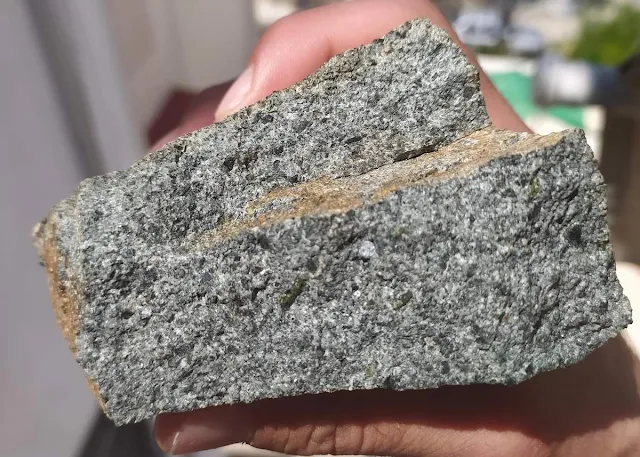 |
| Boninite |
Boninite is a high-magnesium basaltic rock with unique geochemical characteristics, typically found in subduction zone settings. It is considered an extreme variety of basalt.
Origin: Boninite is a rare type of basalt found in island arc settings. It is thought to form from the partial melting of subducted oceanic crust, resulting in a magma rich in magnesium, nickel, and chromium but depleted in other elements.
Composition: Boninite is characterized by its extremely high magnesium content (MgO > 18%) and low silica content (SiO₂ < 55%). It typically contains olivine, orthopyroxene, and clinopyroxene, with minor amounts of spinel and chromite.
Texture: Boninite is typically aphanitic or fine-grained, reflecting its rapid cooling in submarine environments. It can also exhibit a glassy texture due to its low silica content.
Special Characteristics: Boninite is unique in its high magnesium content and depletion in other elements, reflecting its unusual origin from subducted oceanic crust. It provides valuable insights into the processes of subduction and arc magmatism.
Picrite
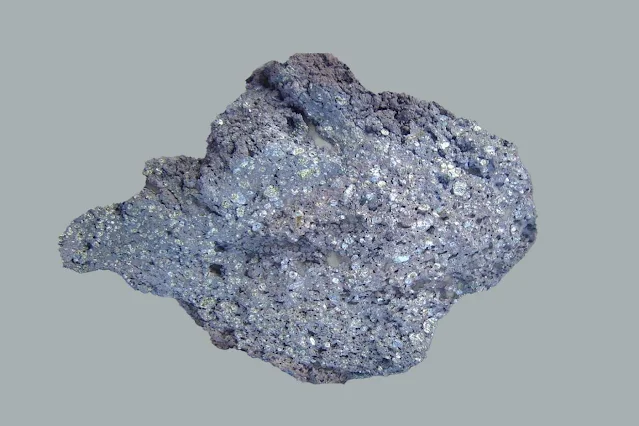 |
| Picrite |
Picrite is another rare type of basalt that is found in island arcs and back-arc basins. It is thought to be formed from the partial melting of mantle peridotite that is enriched in olivine.
Origin: Picrite is thought to form from mantle melts that are relatively undepleted in incompatible elements. These melts can rise to the surface and erupt as picrite lava.
Composition: Picrite is characterized by its high olivine content and its low silica and alumina content. It also typically has a high magnesia content and is enriched in certain trace elements such as nickel and chromium.
Texture: Picrite can have a variety of textures, from aphanitic (fine-grained) to holocrystalline (coarse-grained).
Special characteristics: Picrite is a type of basalt that is rich in olivine, a mineral that is thought to be one of the first to form during the crystallization of mantle rock. Picrite is also known for its occurrence in ophiolites, which are sections of oceanic crust that have been obducted onto land.
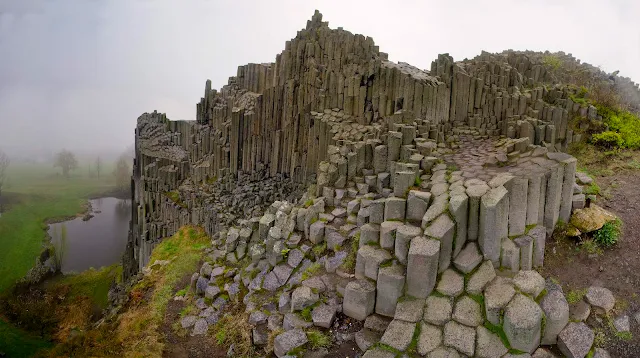 |
| Columnar Basalt, The Panská skála - Czech Republic |
Basalt Structures
Basalt is a fine-grained, dark-colored volcanic rock formed by the rapid cooling of lava at or near the Earth's surface. Its texture and structure are determined by several factors, including the rate of cooling, the composition of the magma, and the presence of gas bubbles.
Columnar Basalt
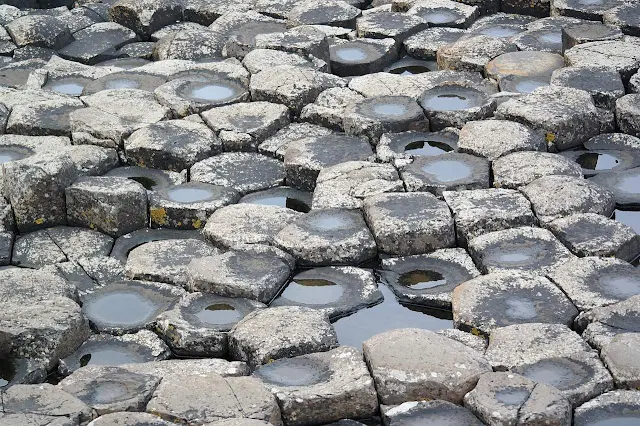 |
| Columnar Basalt |
Columnar jointing is perhaps the most iconic basalt structure, characterized by tall, closely packed columns resembling giant pencils.
Formation: When lava flows cool slowly and evenly, they contract and crack in a regular pattern, typically forming hexagonal columns. This process, called columnar jointing, creates dramatic formations with vertical or tilted columns that resemble giant pipes or stepping stones.
Factors affecting formation: Faster cooling rates lead to smaller, more numerous columns, while slower cooling produces larger, fewer columns. The thickness of the lava flow and the presence of impurities can also influence column formation.
Occurrence: Examples of columnar basalt formations can be found worldwide, including Giant's Causeway in Northern Ireland, Devils Postpile in California, and Fingal's Cave in Scotland.
Pillow Lava
Pillow Lava: This structure is formed when lava erupts underwater and cools rapidly. The lava forms bulbous or sack-like structures with a glassy outer shell and a more crystalline interior. They often have a glassy rind and a more crystalline interior. Pillow lavas are common in oceanic settings and provide valuable information about submarine volcanic activity.
Examples: Mid-ocean ridges, oceanic islands.
Basalt Uses
Basalt finds its way into numerous applications due to its impressive properties. Its strength, durability, and resistance to weathering make it a valuable material across various industries. Here's a glimpse into the diverse uses of basalt:
 |
| Crushed basalt |
Construction
Aggregate: Crushed basalt is widely used as aggregate in concrete, asphalt pavements, and railroad ballast. Its angular shape and high crushing strength contribute to superior structural integrity.
Dimension Stone: Cut and polished basalt slabs serve as aesthetically pleasing and durable flooring, wall cladding, countertops, and paving stones. Its dark color and unique texture add elegance to both indoor and outdoor spaces.
Riprap: Large basalt blocks protect shorelines, embankments, and bridge piers from erosion by waves and currents. Their resistance to abrasion and weathering makes them ideal for such demanding environments.
Industry
Abrasives: Basalt's hardness and wear resistance make it suitable for grinding wheels, sandblasting media, and polishing compounds.
Mineral Wool: Basalt fibers, produced by melting and spinning the rock, provide excellent thermal and acoustic insulation in buildings, pipes, and industrial equipment.
Pipelines and Reinforcements: Basalt fibers offer an alternative to traditional materials in composite pipes and reinforcing bars due to their lightweight nature, high strength, and corrosion resistance.
Environment
Soil Amendment: Crushed basalt can be used as a soil amendment to improve drainage, aeration, and water retention in agricultural settings.
Carbon Sequestration: Basalt reacts with CO₂ under natural conditions, potentially offering a long-term carbon capture and storage solution.
Water Filtration: Basalt-based filters efficiently remove impurities from water and wastewater due to their high adsorption capacity.
Artistic and Sculptural Uses: Sculptors and artists appreciate basalt for its workability and dark color. Basalt is often used for creating sculptures, statues, and other artistic forms.
Basalt Vs Granite
Basalt and granite are both igneous rocks, but they have distinct characteristics due to their formation processes and compositions.
Formation: Basalt forms when lava erupts from a volcano and cools rapidly on the Earth's surface. This rapid cooling prevents large crystals from forming, resulting in its fine-grained texture. Granite, on the other hand, forms from magma that cools slowly deep underground. This slow cooling allows for larger crystals to grow, giving it its coarse-grained texture.
Composition: Basalt is a mafic rock, meaning it has a low silica content and is rich in iron and magnesium minerals like pyroxene and olivine. Granite is a felsic rock, meaning it has a high silica content and is rich in quartz and feldspar.
Appearance: Basalt is typically dark gray to black due to its mineral composition. Granite is light pink to gray with visible crystals of quartz and feldspar.
Basalt is much more common than granite on Earth's surface.
Hardness: Both are strong rocks, but granite is generally harder and more resistant to weathering than basalt.
Conclusion
In conclusion, basalt, characterized by its mineralogical composition and formation through volcanic processes, is a versatile rock with wide-ranging applications in construction, materials science, and geothermal energy harnessing. Its enduring physical attributes make it integral to various industrial processes and engineering endeavors.
Read also:
Pegmatite - Formation, Composition, Properties, Uses
Dunite - Formation, Composition and Properties

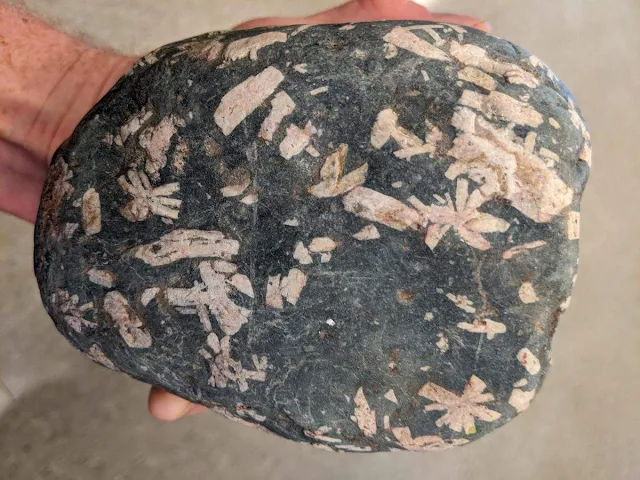

%20(1).webp)


